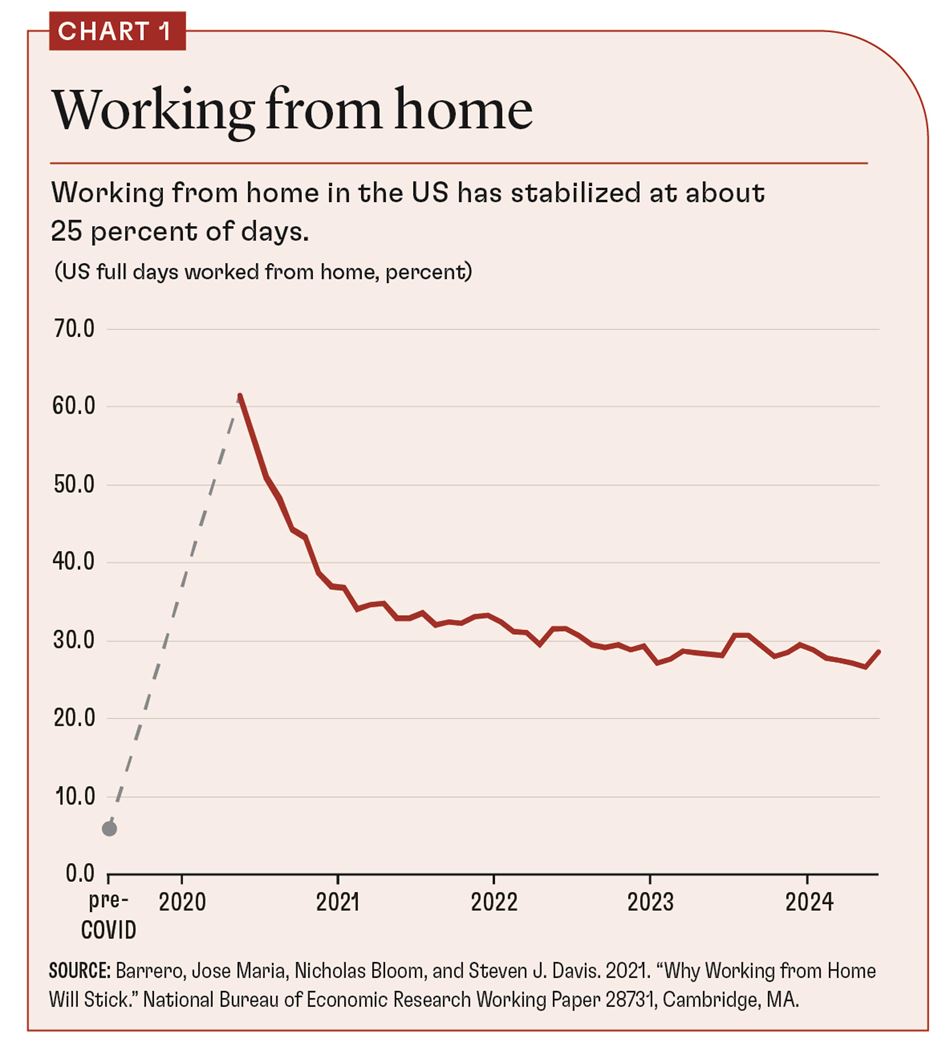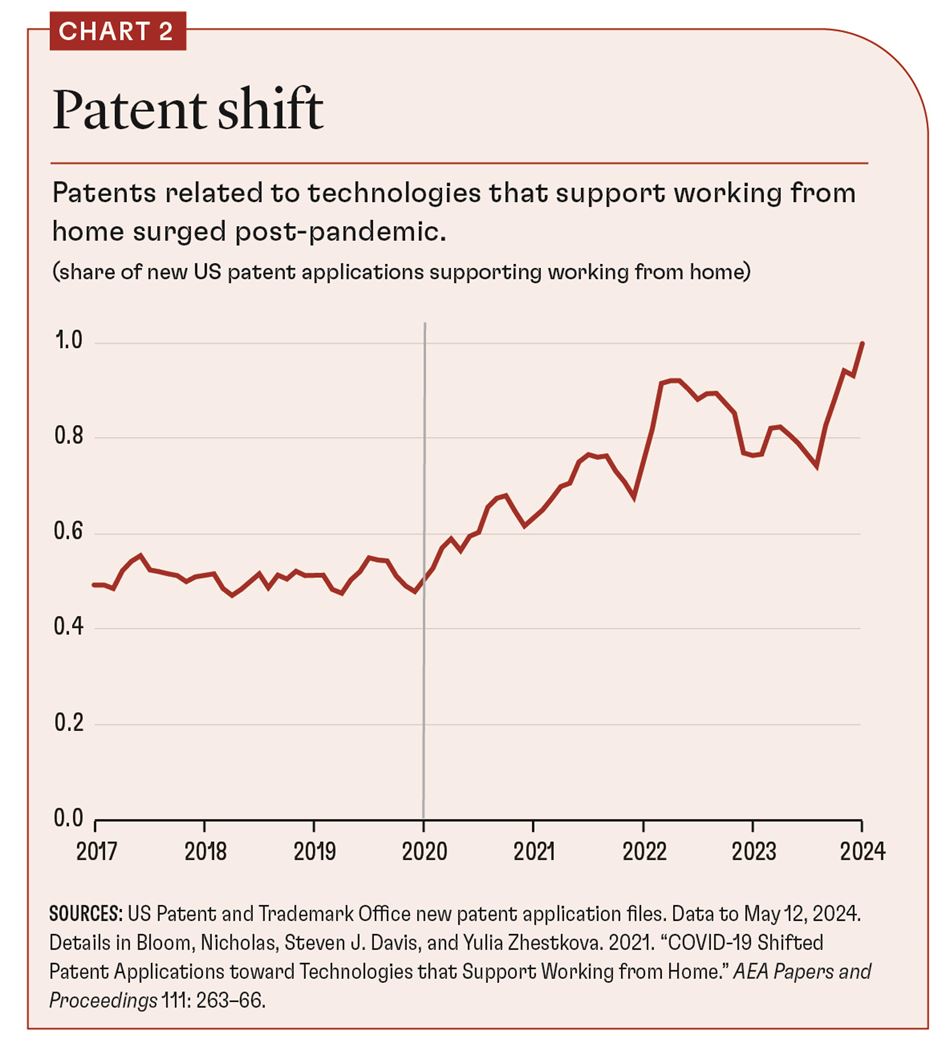A fivefold increase in remote work since the pandemic could boost economic growth and bring wider benefits
Economics is famous for being the dismal science. Sadly, recent work highlighting the slowdown in productivity growth stretching back to the 1950s is no exception. But I take a more cheerful view because of the great productivity gains promised by the pandemic-induced jump in working from home.
Working from home (WFH) increased about tenfold following the outbreak of the pandemic and has settled in at about five times its prepandemic level (see Chart 1). This could counter slowing productivity and deliver a surge in economic growth over the next few decades. If AI yields additional output, the era of slow growth could be over.
The decomposition of economic growth by Nobel laureate Robert Solow, one of the most famous economists of all time, guides my analysis. Solow’s 1957 classic paper highlights how growth comes from both the increase in factor inputs like labor and capital and from raw productivity growth. I hang my analysis on his framework by highlighting in turn how each of these factors will promote faster growth.
Labor
The easiest way to see labor’s impact is the survey evidence from across the United States, Europe, and Asia that shows hybrid work is worth about an 8 percent increase in salary. Hybrid work is the typical pattern for office workers, managers, and other professionals, involving usually two or three days a week away from the office. To understand why employees would consider this to be worth 8 percent of their salary, note that typical workers spend about 45 hours a week in the office, yet they spend close to another 8 hours a week commuting. So working from home three days a week saves them about five hours a week, about 10 percent of their total weekly work and commute time.
Most people really dislike commuting, and so place even greater value on this time savings. See, for example, another famous paper, by the Nobel Prize winner Daniel Kahneman. This research found that commuting is the most detested activity in the day, disliked even more than work itself. This makes it easy to understand why the average employee values working from home so much—with its ability to save hours of painful weekly commuting, alongside the flexibility of being able to live farther from work.
This value of working from home has a powerful impact on labor supply. In the global economy there are tens of millions of people who are on the edge of the workforce. So small changes in the attractiveness of work can bring many millions of them into employment. This marginal labor force includes those with childcare or eldercare responsibilities, those close to retirement, and some folks in rural areas.
One example of this WFH impact on labor supply is the approximately 2 million more employees with a disability who are working in the US following the pandemic. These increases in disability employment have occurred primarily in high-WFH occupations. Employees with a disability benefit in two ways: first, by avoiding long commutes and second, by the ability to control their work environment at home.
Another example is prime-age female employment in the US, which has risen about 2 percent faster than prime-age male employment since the pandemic. Women’s larger role in childcare could be driving this rise in female labor force participation via WFH, according to recent research.
Collectively these effects could increase labor supply by several percent.
Of course, this calculation takes the current population as given. In the longer run, WFH could also increase fertility rates. One story I’ve heard repeatedly from talking to hundreds of employees and managers is how working remotely makes it easier to parent. This is perhaps most salient in East Asia, where long workdays, punishing commutes, and intense parenting pressures have led to rapidly dropping fertility. If parents are able to work two or three days a week at home, particularly with flexible schedules that allow them to share parenting responsibilities, this could increase birth rates. Preliminary analysis based on US survey data suggests perhaps 0.3 to 0.5 more desired children per couple when both work from home one day or more a week.
Capital
The beneficial impact of WFH on capital comes from the longer-term release of office space for other uses, like residential and retail. If employees are based at home two or three days a week, society needs less office space, and that space can be used for other activities. It also reduces commuting traffic, curbing the need for additional transportation infrastructure. More intensive use of our home capital—the space and equipment in our houses and apartments—can allow society to save on the use of transportation and office capital, which can be redeployed to other uses. In major city centers about half of the land is covered in office space, and given that office occupancy is now 50 percent below prepandemic levels, there is great potential for office space reduction.
Recent data on driving speeds show that traffic is now moving about 2 or 3 miles per hour faster during the morning commute, which reduces the need for additional transportation infrastructure and saves the typical commuter a few minutes a day.
Over the longer term, allowing employees to work partially or fully remotely also opens up currently underused land for housing, effectively increasing the usable land supply. Many major cities are heavily congested because most employees do not want to live more than a one-hour commute from the center. If they are required at work only a couple of days a week, longer commutes become possible, opening up space farther outside city centers for housing use.
Collectively, these capital contributions could also raise output a few percent over the coming decades.
Productivity
Classic firm and individual micro studies typically find that hybrid work, the usual pattern for about 30 percent of the US, European, and Asian labor forces, has a roughly flat impact on productivity. WFH benefits workers by saving them from exhausting commutes and typically provides a quieter working environment. But by reducing time at the office, it can also reduce employees’ ability to learn, to innovate, and to communicate. These positive and negative effects roughly offset each other, generating no net productivity impact of hybrid WFH, research suggests.
The impact of fully remote working, which has been adopted by about 10 percent of employees, is highly dependent on how well it’s managed. Some studies that examined fully remote working during the early days of the pandemic found large negative impacts, potentially because of the chaos of the early lockdowns. Other studies found large positive impacts, typically in more self-directed activities, such as call center or data entry work with well-managed firms.
In summary, the impact of fully remote work is perhaps neutral, because firms tend to adopt it only when such work arrangements match the work activity—often tasks such as coding or IT support, carried out by trained employees in a managed environment. But while the micro productivity impacts on any individual firm may be neutral, the huge power of labor market inclusion means that the aggregate macro impact is likely to be positive.
To explain the benefits of labor market inclusion, consider that fully in-person jobs can be filled only by nearby employees. A human resources or information technology position in New York can, for example, be filled only by a local resident. Even if there are people in Bulgaria, Brazil, or Belize who would be a better fit, they cannot do the job if they are not there in person. But as soon as positions can be filled remotely, employers go from taking the best local employee to taking the best regional employee for hybrid and the best global employee for fully remote work.
Recent studies of work discrimination and reallocation highlight how expanding labor markets to a wider pool of potential employees can have massive productivity benefits. Going from 10 to 10,000 qualified candidates for a position allows a far more productive match, particularly if AI can help screen applicants. Remote work enables global matching between employees and firms, boosting labor productivity.
An additional macro productivity benefit from working from home is its positive impact on pollution from transportation. The WFH surge has curbed commuting traffic volumes across the US and Europe by an estimated 10 percent. This has reduced pollution, particularly emissions of low-level heavy particulates. Health studies have linked pollution to cognitive and productivity damage. Lowering pollution not only improves our quality of life but can also increase growth.
Positive feedback loop
A positive feedback loop—from working from home to faster growth and back—boosts these impacts. A long history of market-size effects in economics highlights how firms strive to innovate to serve larger, more lucrative markets. When you go from 5 million to 50 million people working from home every day, major hardware and software companies, start-ups, and funders take notice. This leads to an acceleration of new technologies to serve those markets, improving their productivity and growth.
That feedback loop has already begun. The share of new patent applications at the US Patent and Trademark Office that repeatedly use “remote work,” “working from home,” or similar words was flat until 2020 but has started to rise (see Chart 2). This highlights the improvement in technologies. Better cameras, screens, and software and technologies such as augmented and virtual reality and holograms will increase the productivity of hybrid and remote work in the future. This will generate a positive feedback loop between growth and working from home.
One critique of the boom in working from home is the damage to city centers. It’s true that retail spending has fallen in city centers, but this activity has relocated to the suburbs, and overall consumption expenditure has resumed its prepandemic trend. Perhaps more problematic is the large reduction in valuations of commercial office space. Although this represents a loss of valuation for investors in the office sector, the release of city center space for residential use will in the long run make downtown living more affordable. The cost of living in the city rose dramatically in the 1990s and 2000s, pricing many middle- and lower-income employees out of city centers. This is especially problematic as many of these workers provide essential services, such as firefighting, policing, teaching, health care, food, transportation, and other work that can only be done in person. Cutting the amount of space for office use in city centers and converting it to residential use would make housing more affordable for these essential workers.
The 2020 surge in working from home has helped offset the prepandemic productivity slowdown overall and is boosting present and future growth. Being an economist usually means balancing winners and losers. Analyzing changes in technology, trade, prices, and regulations usually has mixed effects, with large groups of winners and losers. When it comes to working from home, the winners massively outweigh the losers. Firms, employees, and society in general have all reaped huge benefits. In my lifetime as an economist I have never seen a change that is so broadly beneficial.
This leaves me in the unusual place of being an optimistic “dismal scientist.” But it’s a place I’m happy to be as I write this while working from home.
Podcast

Working from home was not an option for most people before March 11, 2020, when work and home life suddenly collided. Stanford University's Nicholas Bloom was studying the potential impact of remote work long before the pandemic launched it into the mainstream and now has data to suggest businesses should stick to the hybrid working model.
Opinions expressed in articles and other materials are those of the authors; they do not necessarily reflect IMF policy.










